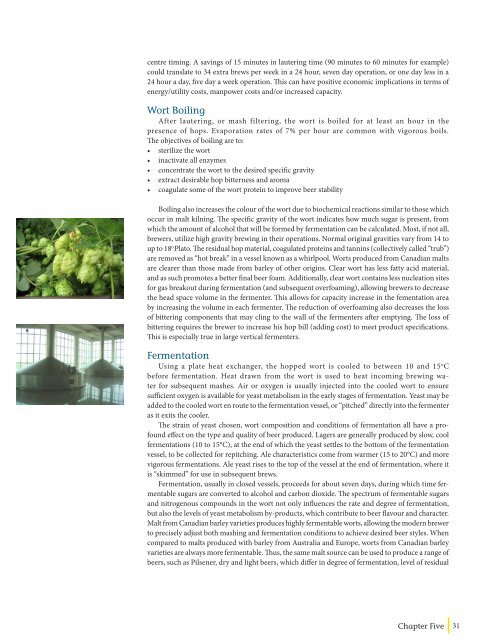MALTING QUALITY TRAITS - Canadian Malting Barley Technical ...
MALTING QUALITY TRAITS - Canadian Malting Barley Technical ...
MALTING QUALITY TRAITS - Canadian Malting Barley Technical ...
Create successful ePaper yourself
Turn your PDF publications into a flip-book with our unique Google optimized e-Paper software.
centre timing. A savings of 15 minutes in lautering time (90 minutes to 60 minutes for example)<br />
could translate to 34 extra brews per week in a 24 hour, seven day operation, or one day less in a<br />
24 hour a day, five day a week operation. This can have positive economic implications in terms of<br />
energy/utility costs, manpower costs and/or increased capacity.<br />
Wort Boiling<br />
After lautering, or mash filtering, the wort is boiled for at least an hour in the<br />
presence of hops. Evaporation rates of 7% per hour are common with vigorous boils.<br />
The objectives of boiling are to:<br />
• sterilize the wort<br />
• inactivate all enzymes<br />
• concentrate the wort to the desired specific gravity<br />
• extract desirable hop bitterness and aroma<br />
• coagulate some of the wort protein to improve beer stability<br />
Boiling also increases the colour of the wort due to biochemical reactions similar to those which<br />
occur in malt kilning. The specific gravity of the wort indicates how much sugar is present, from<br />
which the amount of alcohol that will be formed by fermentation can be calculated. Most, if not all,<br />
brewers, utilize high gravity brewing in their operations. Normal original gravities vary from 14 to<br />
up to 18 o Plato. The residual hop material, coagulated proteins and tannins (collectively called “trub”)<br />
are removed as “hot break” in a vessel known as a whirlpool. Worts produced from <strong>Canadian</strong> malts<br />
are clearer than those made from barley of other origins. Clear wort has less fatty acid material,<br />
and as such promotes a better final beer foam. Additionally, clear wort contains less nucleation sites<br />
for gas breakout during fermentation (and subsequent overfoaming), allowing brewers to decrease<br />
the head space volume in the fermenter. This allows for capacity increase in the fementation area<br />
by increasing the volume in each fermenter. The reduction of overfoaming also decreases the loss<br />
of bittering components that may cling to the wall of the fermenters after emptying. The loss of<br />
bittering requires the brewer to increase his hop bill (adding cost) to meet product specifications.<br />
This is especially true in large vertical fermenters.<br />
Fermentation<br />
Using a plate heat exchanger, the hopped wort is cooled to between 10 and 15 o C<br />
before fermentation. Heat drawn from the wort is used to heat incoming brewing water<br />
for subsequent mashes. Air or oxygen is usually injected into the cooled wort to ensure<br />
sufficient oxygen is available for yeast metabolism in the early stages of fermentation. Yeast may be<br />
added to the cooled wort en route to the fermentation vessel, or “pitched” directly into the fermenter<br />
as it exits the cooler.<br />
The strain of yeast chosen, wort composition and conditions of fermentation all have a profound<br />
effect on the type and quality of beer produced. Lagers are generally produced by slow, cool<br />
fermentations (10 to 15°C), at the end of which the yeast settles to the bottom of the fermentation<br />
vessel, to be collected for repitching. Ale characteristics come from warmer (15 to 20°C) and more<br />
vigorous fermentations. Ale yeast rises to the top of the vessel at the end of fermentation, where it<br />
is “skimmed” for use in subsequent brews.<br />
Fermentation, usually in closed vessels, proceeds for about seven days, during which time fermentable<br />
sugars are converted to alcohol and carbon dioxide. The spectrum of fermentable sugars<br />
and nitrogenous compounds in the wort not only influences the rate and degree of fermentation,<br />
but also the levels of yeast metabolism by-products, which contribute to beer flavour and character.<br />
Malt from <strong>Canadian</strong> barley varieties produces highly fermentable worts, allowing the modern brewer<br />
to precisely adjust both mashing and fermentation conditions to achieve desired beer styles. When<br />
compared to malts produced with barley from Australia and Europe, worts from <strong>Canadian</strong> barley<br />
varieties are always more fermentable. Thus, the same malt source can be used to produce a range of<br />
beers, such as Pilsener, dry and light beers, which differ in degree of fermentation, level of residual<br />
Chapter Five<br />
31


